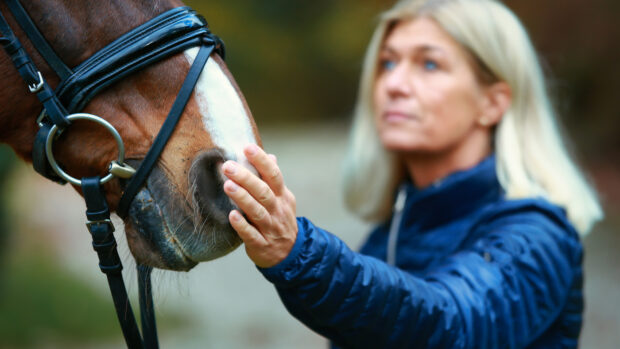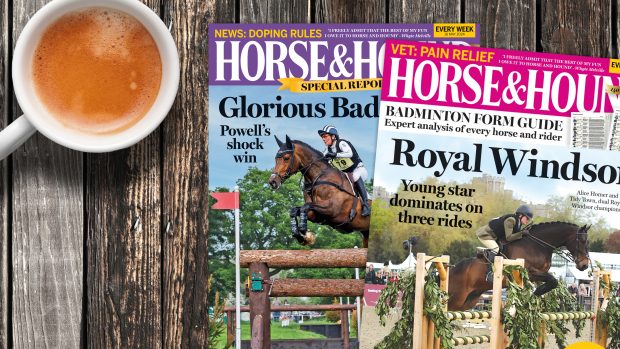Promotional Feature with NAF
By Dr Andy Richardson BVSc CertAVP(ESM) MRCVS, NAF veterinary director
Horses have a unique role as our partner in ridden exercise. All horses that are asked to undertake exercise on our behalf should be considered as “athletes” – not just those competing at an elite level.
As riders, we ask horses to do a job that involves coordinated movement of the musculoskeletal system and therefore a degree of fitness. Of course, different disciplines will involve different degrees of exercise intensity. However, whenever we ask a horse to carry us as riders it is important to consider how best to train, maintain fitness and reduce unwanted injury or soreness.
All disciplines – from hacking and schooling all the way up to the ultimate tests of equine athleticism in elite competitions require the musculoskeletal system to function effectively.

Andy Richardson
Equine musculoskeletal system
The equine musculoskeletal system is made up of over 200 bones and 700 muscles. Tendons attach muscles to bone and ligaments attach bones to one another.
There are two main types of muscle in the horse’s body, as there are with us – skeletal (striated) and smooth muscle. Skeletal muscles respond to messages sent from the brain via nerve impulses; they can be actively controlled and coordinated to move body parts – for example limb movement, chewing or tail swishing. Over 50% of the body mass of athletic horses comes from skeletal muscle – so a fit competition horse can easily have over 250kg of lean muscle mass as part of its body weight.

Smooth muscle contracts in a much slower fashion and is involuntary – in other words there is no active control of this movement. An example would be the smooth muscle in the wall of the intestines that controls the passage of food through the gut.
It is the contraction and relaxation of skeletal muscle that allows a horse to move, and these processes take place at a microscopic level in the muscle fibres. Skeletal muscle is comprised of two main types of muscle fibres – type one (slow twitch) and type two (fast twitch). The ratio of slow twitch vs fast twitch is down to genetic predisposition, but can also be influenced by training. A thoroughbred for example will naturally have more fast twitch fibres than a native pony. However, long and slow exercise will increase the amount of type one muscle fibres while fast/intense exercise will increase the amount of type two fibres.
Training
Skeletal muscle responds and adapts to training. Just like humans, horses must be fit enough to be able to complete an appropriate period of exercise. Asking a horse to do more than their level of training has prepared them for will increase the risk of injury, as well as likely result in a below par performance.
So training is key and needs to be done gradually and regularly, in combination with appropriate rest and diet.
Training should start by achieving a base level of fitness that builds up a core of type one muscle fibres as a response to long, but controlled, exercise at a low to moderate intensity. Examples would be walker exercise or hacking, working up to a 45-minute trotting hack. This will allow type one muscle fibres to develop and act as a base for the faster twitch fibres that can be worked on later on in a training programme. Low intensity training, such as hacking, should be done for at least four weeks in an unfit horse before starting to introduce exercise that will develop muscle mass and fast twitch fibres.
“Gym” work in horses would include shorter bursts of canter or gallop, in combination with collected movement, lateral work, pole work, small obstacles and cavaletti exercises.
For most horses, the key is achieving balanced muscle development. All areas of the body should be worked on, with a combination of low intensity stamina work and higher intensity exercise. This is common sense but is also backed up by science, with studies showing how muscle development and growth are best established with a combination of maintenance training and bouts of intense exercising¹.
Ideally, try and train on a variety of surfaces – road work, schooling and on the grass if possible. Avoid extremes of ground other than low intensity work on the roads.
Don’t forget the brain!
Most horses enjoy exercise, but variety is essential to keep their brains fit and healthy. Repetition of the same work will not only limit the degree of muscular development and fitness, it can also become quite tiresome and lead to behavioural issues. It is therefore a good idea to keep the exercise programme varied.

How much rest?
There is no “one size fits all” answer to this. The amount of rest your horse should get between exercise sessions depends on the intensity of the exercise and their level of fitness.
To help understand this, studies have shown that if the training load is balanced with the individual horse’s exercise tolerance, regenerative processes will restore or increase athletic performance within a couple of days². In other words, as long as the degree of exercise is not excessive relative to fitness level, muscles will either recover to their original level or have increased in size/strength within two days. So, after an intense period of exercise such as a competition, it may be advisable for most horses to have two days of a lower level of exercise afterwards.
It is important to say however that low intensity exercise is normally beneficial every day, rather than complete rest. This may be as simple as turnout, spending some time on a walker, or a walking hack the day after intense exercise. Box rest is rarely beneficial, unless specifically advised by your vet for a particular reason.
Post-exercise stiffness
It is important to recognise that the process of muscle breakdown and repair is a normal adaptive response to training. This process can lead to inflammation and soreness or stiffness after exercise. In humans, there is a well-recognised condition called Delayed Onset Muscle Soreness (DOMS).
Further research is required to fully understand the impact of DOMS in horses. DOMS is the muscular pain that develops 24-72 hours after a period of intense exercise. There is no pain felt by the muscles at the time of exercise, in contrast to a pulled (torn) muscle or tying-up (see below) for example.
In humans, DOMS is now known to be the result of tiny microscopic fractures in muscles cells³. This happens when doing an activity that the muscles aren’t used to doing or have done in a more strenuous way than they are used to.
The muscles quickly adapt to being able to handle new activities so as to avoid further damage in the future; this is known as the “repeated-bout effect”. When this happens, the micro-fractures typically won’t develop unless the activity has changed in some substantial way. As a general rule, as long as the change to the exercise is under what is normally done, DOMS are not experienced as a result of the activity.
In practice, avoiding any post exercise muscle soreness in a training programme may be unavoidable, as exercise intensity and duration increases. Horses, like us, are far from being machines, so there is fine balance between a programme that gets a horse fit for purpose without some post exercise muscle discomfort.
If you notice muscle soreness or stiffness during the period of one-three days after a period of exercise, the opinion of your vet should be obtained to rule out any specific injury or disease. Potential treatments for DOMS may include the use of anti-inflammatories, physiotherapy and gentle exercise. Judicious use of anti-inflammatories under veterinary advice can be helpful to make any light exercise or physiotherapy comfortable for your horse.
Exercise will also lead to a process of muscle cell damage caused by oxidative stress. This is an inflammatory process and recovery from oxidative stress is key to allow for muscle cell repair and growth. Antioxidants are compounds that help recovery and repair of muscle cells following periods of intense exercise. The process of oxidative stress in muscle cells can lead to muscle fatigue and inflammation if left unsupported. Antioxidant supplementation can help protect against excessive oxidative stress and support muscle repair after exercise.
Tying-up
Tying-up, also known as azoturia, set fast or Monday morning disease is best described by the term recurrent exertional rhabdomyolysis (RER). RER is a specific condition that occurs at the time of exercise. Clinical signs include: muscle spasms or muscle trembling, stiffness or hard muscles, high heart rate, sweating, muscle pain, reluctance to move or lying down, and the passing of red-brown urine. It can vary in severity from mild to severe and veterinary assistance should always be obtained if suspected.
There are many factors involved in the occurrence of RER including genetics, diet and training programme. A full discussion is beyond the scope of this article, however general tips to avoid it would include daily turnout or exercise, a gradual fitness programme and a high fibre/low starch diet.
PSSM (polysaccharide storage myopathy) is a specific type of rhabdomyolysis that certain breeds are predisposed to. The clinical signs are often less severe than that described above for RER, however the recurrent nature of PSSM can make it problematic. It can be diagnosed through genetic testing and muscle biopsies.
Conclusion
Achieving and maintaining an athletic horse that can enjoy exercising to the level you ask requires consideration of lots of different factors. These include the training programme, diet and advice from professionals such as vets, physiotherapists and nutritionists. The exercise programme should be achievable and tailored to the individual, with attention paid to both the physical and behavioural well-being of your horse.
References
1. Rivero, J.-L.L. et al. (2007) Effects of intensity and duration of exercise on muscular responses to training of thoroughbred racehorses. Journal of Applied Physiology 102(5), pp. 1871–1882.
2. Wijnberg, I. D., van Dam, K. G., Graaf-Roelfsema, E. de, Keizer, H. A., van Ginneken, M. M. E., Barneveld, A., Breda, E. van, & van der Kolk, J. H. (2008). (Over)training effects on quantitative electromyography and muscle enzyme activities in standardbred horses. Journal of Applied Physiology, 105(6), 1746–1753.
3. Hotfiel, T et al. (2018) Advances in Delayed-Onset Muscle Soreness (DOMS): Part I: Pathogenesis and Diagnostics. Sportverletz Sportschaden 32(4):243-250.




